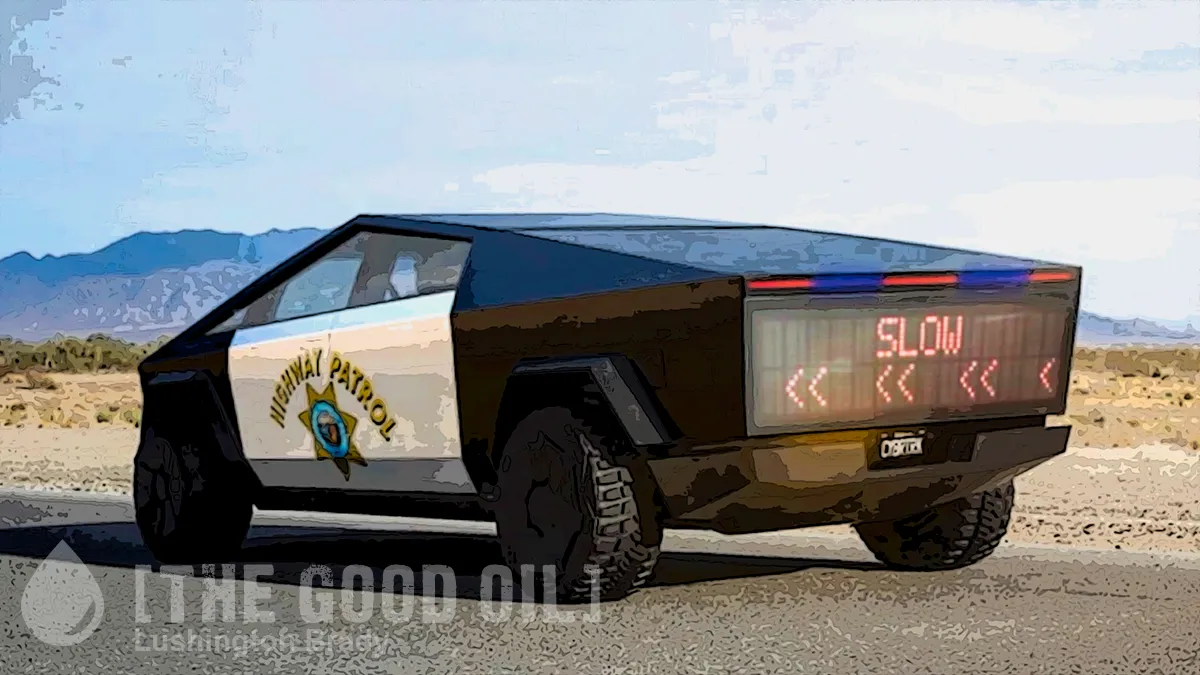Elon Musk’s SpaceX is revolutionising space exploration by taking it to the private sector and getting government out of the way. If only the same could be said for his other flagship company, Tesla.
Tesla is a quintessential crony capitalist business, relying on massive tax breaks, subsidies and government mandates to keep it afloat: such as in California, which plans to ban new petrol-fuelled vehicles by 2035. As part of its all-electric push, California police departments are transitioning to electric vehicles.
How’s that working out for them?
Police in California are experiencing what happens when good intentions crash into reality […]
To get ready for [the] brave new world some police departments started with buying a few Teslas. These departments immediately ran into serious problems using the vehicles as cruisers, such as a lack of charging infrastructure, inadequate interior space, expensive and lengthy retrofitting processes, interference from advanced driver safety assistance systems and more. Police Chief Cedric Crook for the Ukiah, California police department told San Francisco Gate he doesn’t think the department’s Model 3s will see action any time soon.
It’s not just the embarrassment of running out of charge mid-pursuit. Even if they run down the perps, cops better hope there’s just the one.
The car has other issues, namely size. Tesla back seats “only have room for one prisoner,” Crook said, limiting an officer’s ability to sequester suspects. With an all-Tesla police force, Crook believes incidents involving more than one party will require more officers to respond with more cars, putting strain on resources, all because of the tiny back seat.
This isn’t just an issue for police trying to make on-the-spot arrests (assuming the car made it there in the first place). Imagine having to stop and spend an hour or so at a charging, with Harry the psycho-mass-murderer in the back seat.
Police are often required to transport suspects, witnesses or victims for cases they’re working, sometimes for long distances. Crook remembered a case where his detectives drove 630 miles to Mexico to transport a potentially dangerous subject in their vehicle. If the detectives were in a Tesla, Crook noted they would have had to spend an hour in the middle of the drive at an unsecured public charging station standing guard over the person, something that would not happen with an internal combustion engine.
That’s just the beginning…
Furthermore, Crook told SFGATE that he’d heard officers were unable to comfortably get in and out of the driver’s seat with their duty belt on because of the Tesla’s design. Police duty belts generally weigh between 20 and 25 pounds, adding bulk to an officer’s torso, which may not fit within the slim, streamlined Tesla aesthetic.
Another concern Crook has about Teslas, and EVs broadly, comes from an essential lesson he was taught in the police academy: “In a firefight, hide behind the engine block.” In a Tesla, there is no engine block, leaving officers without their preferred cover, he said.
They can always hide behind the battery. I’m sure nothing can go wrong if a massive lithium-ion battery gets hit by a few bullets.
The Model Y is not much better than the Model 3, according to Menlo Park officers and while public chargers are on the rise, police have struggled to find and use them. Another problem is an inability to do cop things like jump curbs, due to autopilot programing.
On the other hand, the autopilot might have no compunction about mowing down a fleeing suspect. Especially if they’re dressed as a deer.
Tesla’s approach to automotive autonomy is a unique one: Rather than using pesky sensors, which cost money, the company has instead decided to rely only on the output from the car’s cameras. Its computers analyze every pixel, crunch through tons of data, and then apparently decide to just plow into deer and keep on trucking.
Photos and video posted to Twitter by @TheSeekerOf42 show the before and after of a deer strike, during which the poster claimed he was using Tesla’s “Full Self-Driving” software. Video shows the car approaching a deer in the road without slowing, and a photo of the front of the car shows the resulting damage: A cracked bumper, and a hood that’s both dented and “shifted almost an inch toward the windshield.”
The driver remains a rusted-on Tesla fanboi, though, dismissing the deer-mashing incident as an ‘edge case’.
One might argue that edge cases are actually very important parts of any claimed autonomy suite, given how drivers check out when they feel the car is doing the work […]
This is the sort of edge case where LiDAR would have really helped. The Tesla’s computer vision appears to have missed the light-colored deer against the lighter-colored strip of pavement on the road, but sensors with actual 3D detection capabilities would likely have noticed the solid object standing in the car’s way.
Even more concerning than the lack of detection, however, is that the Tesla reportedly didn’t stop even after hitting the deer. No impact sensor or camera noticed the crash and told the car to pull over, slow down, or even relinquish control back to the driver. A deer strike is generally a considerable impact to a car, especially when the strike manages to relocate the entire hood, but the Tesla either didn’t notice or just decided it wasn’t an issue.
I guess we’ve finally found a use for Teslas: dealing with ‘climate’ protesters and Antifa/BLM mobs blocking roads.









